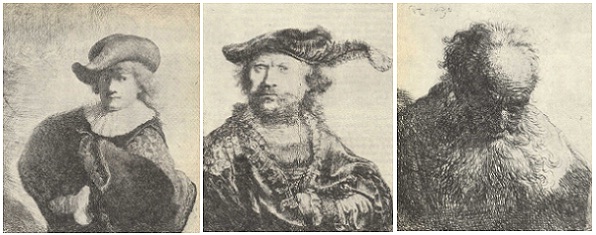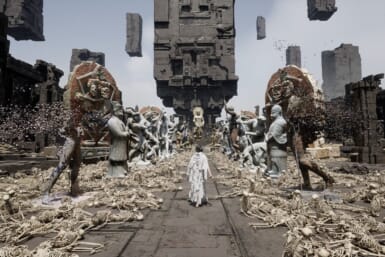by Fred Harris
Rembrandt Re-Visited
It’s been a few years since I’ve written about my favorite artist—Rembrandt. He died in 1669 and this marks the 320th anniversary of the master’s death. After this long length of time his pictures are still very much alive, and part of our modern world, that in viewing an exhibition of his prints or drawings one would think they were done yesterday. Not only is his technique modern looking but the spirit behind the subject still pulls us into the depths of the picture.
The only written statements we have from Rembrandt are a series of letters he wrote to Constantijn Huygens, secretary to Prince Frederick Henry of Orange, regent of the United Netherlands. These letters were written when he was only 33 years old but already refer to the spiritual preparation in his art, by such statements as “…In both these paintings I have concentrated on expressing the greatest inward emotion.”
In looking at Rembrandt— and in my opinion only Rembrandt — do we feel that technical skill and virtuosity are not sufficient to create works of art that will endure. Unfortunately, as with other popularized artists (through novels and movies), the public is subjected to stories which make good reading but are not always the truth.
In Rembrandt’s case we have the romantic view of the artist as a worldly gentleman who late in life turned into a silent philosopher bent upon exploring the mysteries of the soul. In the 30 years since the above letter was written (at 33) he suffered personal tragedies — the most severe being the loss of his wife Saskia. However even in his earliest self portraits he shows himself as a person with a deep desire to understand himself.
As an example he spent an unusual amount of effort describing a deep understanding of old age. Using his parents as models be found a beauty in age that has never been equaled, except by his own self-portraits which describe his own face as an old man.
In more than 90 self portraits that begin at the outset of his career in the 1620s to the year of his death in 1669, he created an autobiography in art that is the equal to the finest ever produced in literature.
Rembrandt was very much a free spirit, similar to today’s free lance artist. He lived and acted according to his own rules of conduct and produced a body of work in accordance with his own aesthetic preferences. When we count the number of surviving works, about 600 paintings (many of them quite large), 300 etchings and more than 1.000 drawings we have to realize that he must have spent the better part of his life in the confines of his studio, yet he was not alienated from life.
He met and sketched many simple folk, as well as members of the local Jewish community, foreigners and ordinary beggars. His withdrawal into the studio did not mean a withdrawal from life; instead it caused him to react with a more sensitive feeling for human qualities.
After reaching middle age he seems to have lived modestly within a narrow circle of family, friends, pupils and models. He was not interested in “high society” although he painted himself dressed in fine robes with all kinds of golden decorations. These middle age portraits place Rembrandt on the level of Da Vinci, Durer and Titian by their technical achievement alone.
As he grew older the painter’s smock replaces the fancy cloak. There are no longer any gold ornaments. Rembrandt’s face becomes deeply lined, with sad looking eyes, and hair under his cap that becomes thin.
His last self portrait was painted when he was only 63, but it looks as if he’d seen 100 years of tragedy. Unlike Durer and Rubens who flattered themselves with their own likeness, Rembrandt was not ashamed to expose his bulbous nose, course features and flabby face.
Commissioned portraits of course are another world apart. When paid to produce a likeness, the artist has to render the sitter’s features accurately, or even more important make him or her more attractive. Rembrandt managed to succeed. The patron recognized himself — as a faithful likeness, while the picture also fulfilled the artist’s own intentions.
However Rembrandt’s greatest portraits other than his own arc of the paupers who sat for him for a few pennies. He felt attracted to these people by their picturesqueness, with the full knowledge that he may never find a buyer for these canvases. With these pictures he was able to pay attention to aesthetic problems only, a special light effect, or color change due to the lighting.
His brush work on these paintings become freer and finally the color was applied in a thickness that anticipates works by the 20th century expressionists. This style did not receive much approval. Critics called his colors crusts of mud. One such critic said “…pictures had paint so thick that it could be lifted from the floor by the nose.”
Rembrandt was an individualist who belonged to no sect, a nonconformist who wanted nothing more than to express with all the means at his disposal his inner vision. It is this uniqueness about him that makes him so timeless and universally accepted. He is without a doubt the most important part of my world of art.









